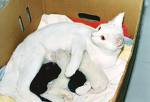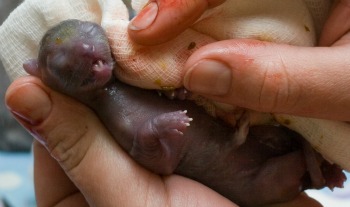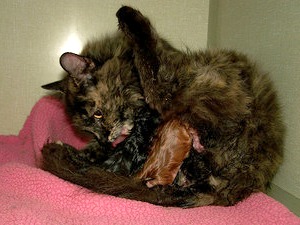Cats Giving Birth to Kittens
"Are you prepared for
this magical moment?"
The First Steps to Take
Cats giving birth to kittens are wonderful to watch and be a part of. Your feline's natural instincts will handle most of the details. However, your female cat (or "queen") may be a little nervous if this is her first time delivering kittens.
Here are the basic steps you need to take:
- Keep calm
- Prepare a clean quiet place for the births (although, be open to your kitty choosing a different place!)
- Be prepared for complications
You can help your pregnant kitty by treating her normally and not making a big deal of things. Feline pregnancy is a normal and natural part of a cat's life.
If you're nervous or anxious, your cat can sense this and it may contribute to her anxiety, especially if it's her first delivery.
If you need more information about taking care of your cat during pregnancy, please take a look at our Care for a Pregnant Cat page.
For help preparing for the kitten birth, see Cat Pregnancy and Birth.
Here's what to expect during the birthing part of cats giving birth to kittens:
Labor Stages of Feline Pregnancy
There are essentially three stages of the birthing process:
- labor,
- delivery, and
- afterbirth.
Labor can begin as early as 61 days and as late as 70 days after conception.
If you don't know the exact date of conception, it's best to be prepared several days in advance of when you think your cat may deliver her newborn kittens.
Stay close by during labor and the births. This isn't the time to go on an extended vacation!
First Stage of Labor
The first sign of labor for cats giving birth to kittens is restlessness with some growling or rhythmic purring.
You might also be able to observe some shallow and rapid breathing, and possibly a slight flaring of your kitty's nostrils during the beginning faint contractions. You'll also probably see some vaginal discharge.
 Mama with Kittens in Kittening Box
Mama with Kittens in Kittening BoxThe momma-to-be may start fussing with her bedding or, hopefully, the bedding in the kittening box
you've prepared for her.
This stage can last as long as 24 hours.
Second Stage of Labor (The Delivery Stage)
This stage is the big time!
Now your pregnant cat will start to have major contractions. She'll be breathing deeply and you'll see visible movement and shuddering of her belly.
In the beginning, the contractions for cats giving birth to kittens may be once every 30 minutes and possibly longer. They gradually become more frequent and occur every 30 seconds until right before the birth of the first kitten.
Your healthy kitty may continue to growl and purr and she may repeatedly lick her vaginal area; this stimulates the birth of the kittens.
This stage can take quite a while depending upon the number of kittens being born (4-6 newborns is typical).
Timing of the Births
When the contractions become more frequent, the birth of the first kitten will normally happen within 20 minutes. The next kittens may come out in rapid succession or in longer intervals.
In some cases, the entire delivery process of all the kittens could even last as long as 24 hours, especially for larger litters. A typical litter size is four to six newborns.
If it looks like labor and delivery is going to be long, your cat will need some nourishment. Offer her a small amount of her favorite food and some water.
The Actual Birth
Kittens are usually, but not always, born head first (up to one-third are breech births—i.e., the feet come out first—pay particular attention to this situation as the new momma may need help getting out the breeched newborn).
Each newborn will be in a membrane sac with fluid. If the sac does not burst when it comes out, the queen will rupture the sac with her tongue.
The momma then starts cleaning the kitten by licking away the fluid from her nose and mouth; this stimulates the newborn to breathe.
When the kitten cries and flexes its little body, then you know that all is well.
Stage Three: The Afterbirth
After licking the kitten dry, the new mother cat will then bite the umbilical cord. She usually eats the umbilical cord along with the placenta (which comes out with secondary contractions) and the remains of the birth sac.
Don't freak out. This is normal cat behavior, and actually gives the new mom extra nutrients and energy.
You should pay attention to the number of placentas (or "afterbirths") coming out. There should be one for each kitten. If there isn't, you should contact your veterinarian to remove them. Left inside, the afterbirth will cause an infection.
Usually instinctively, the newborn kitten will crawl toward its mother's warm body and look for a nipple to suck. Or the queen may move the kitten towards a nipple.
All is well. Congratulations to you and the new mom!
Helping Your Cat Deliver Her Kittens
Some cats giving birth to kittens prefer to be on their own at the delivery stage. The momma-to-be may want to be in her kittening box and in the dark while giving birth.
Other kitties, especially first time feline moms, may need your presence and encouragement.
Keep her calm. Encourage her with gentle words. Reassure her. You may want to just stay nearby with a good book. Be sure to keep kids and other pets away. Of course, it's wonderful for some kids to witness this process, but just make sure they know that the mom-to-be needs some quiet.
Complications for Cats Giving Birth to Kittens
The kitten delivery process described above is the normal process with no complications. Be sure to have your veterinarian's number, and a 24-hour emergency pet hospital number, nearby in case of complications.
Complications can happen, for example, if one of the legs of a kitten cannot be pushed out and it remains trapped inside of the birth canal.
 Newborn Kitten Getting a Little Extra Help
Newborn Kitten Getting a Little Extra HelpYou can find more information online about what to do in case of complications.
However, since I have only experienced a normal birth with one of my cats (before I realized the extreme importance of spaying and neutering), normal births are really all I can write confidently about.
Most cats giving birth to kittens will have no problems whatsoever and you will probably be just fine, but personally, if I were caring for a pregnant cat today, I would consult my trusted veterinarian for advice on what to do to prepare for complications; and I would make absolutely certain that I had a couple of emergency phone numbers nearby.
Remember, I'm not a vet, just a cat love like yourself.
Related Information
Cat Pregnancy Symptoms - What to look for to determine if your kitty is pregnant. Cat Pregnancy Calendar and what to expect during feline pregnancy.
Kitten Growth - Learn about the stages of kitten growth and development.
Use Google to search this site for more information about feline health issues and cat care.
From Cats Giving Birth to Kittens to My Healthy Cat home
If you suspect your cat is ill, please contact your veterinarian immediately.
The material presented in this site is for informational and entertainment purposes only. It is not intended to replace your veterinarian's advice.
Copyright 2003-2023 © www.myhealthycat.com
Sitemap | Contact Us | About Us | Disclosure | Privacy Policy


